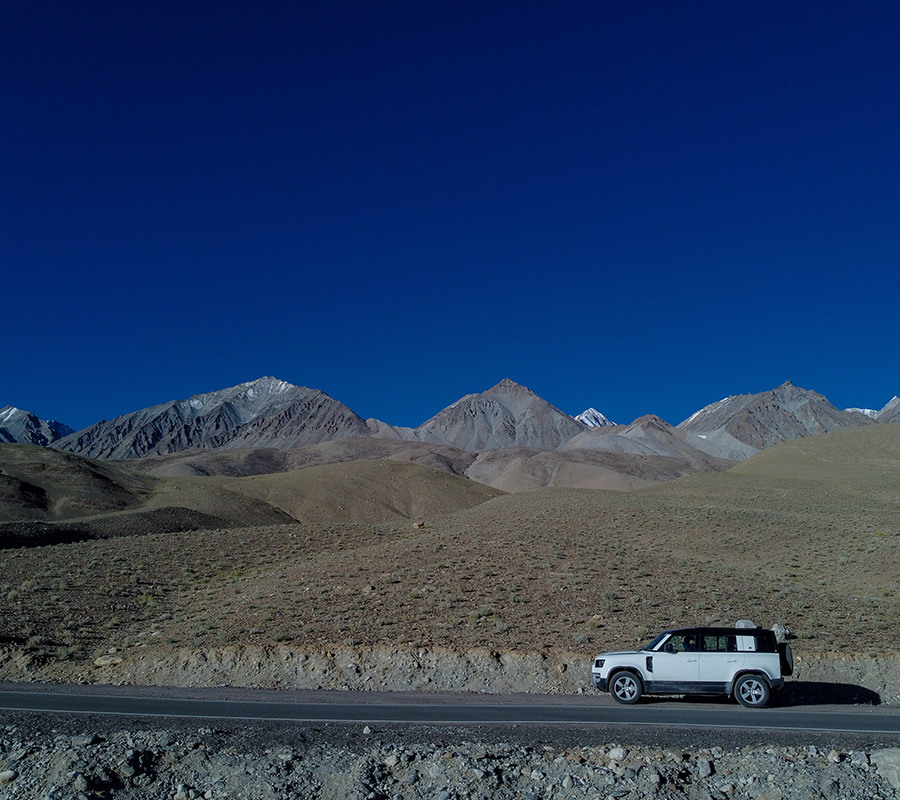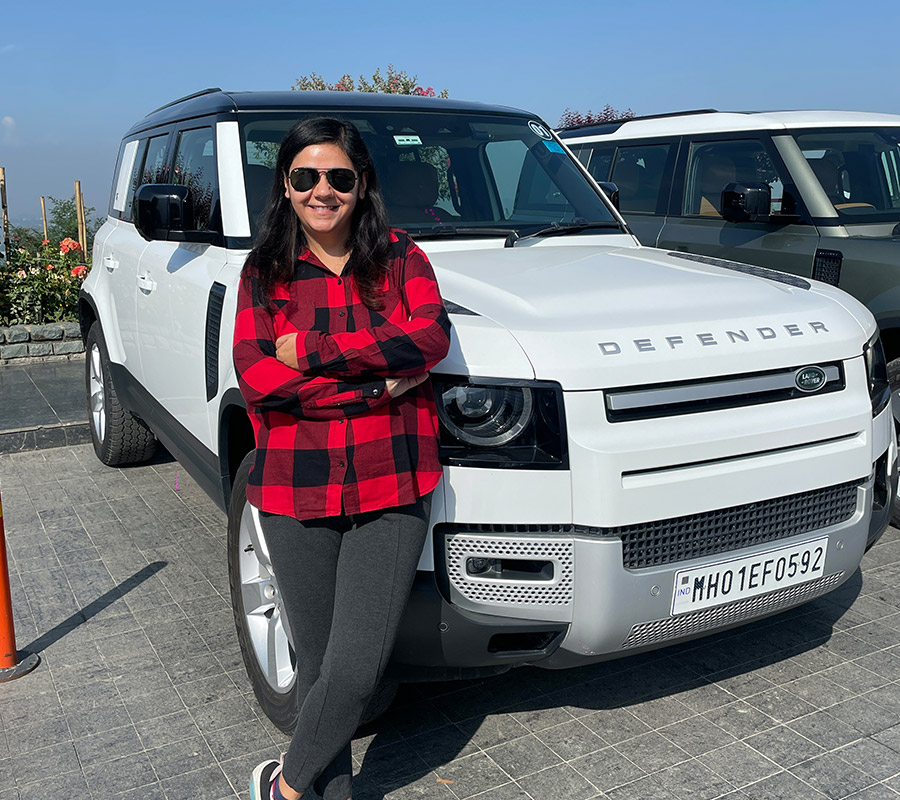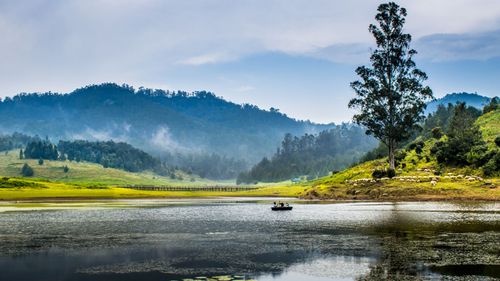“Just stay in your lane and go slow on the blind curves. The road is fairly smooth, so you will be fine,” Ambady Anil, who is guiding me on how to maneuver the Land Rover Defender 110 SE through the Himalayas tells me reassuringly. “You can do this,” I tell myself as I nervously put the automatic gear into drive mode and gently press the accelerator.
Our destination is Kargil town, 53km away from our last halt at Kargil War Memorial. I am a bundle of nerves because this is the first time I am behind the wheel in the mountains, but luckily the road on National Highway 1 is not too winding. Whenever the curves come, I follow Anil’s instructions and it is easier than I thought. As I proudly stop the car at the hotel, I feel a sense of accomplishment—now nothing can stop me from zipping around the mountains.

I have joined an epic road trip where 18 of us are driving five Defenders across the Himalayas from Kashmir to Ladakh. It is one of a series of drives called Defender Journeys, conducted in the country by Land Rover India with Cougar Motorsports.
While the breathtaking terrain we traverse takes us from lush mountains to a stark, brown landscape, what stays imprinted in the mind forever is the luxury that cocoons us through the trip—whether it is the vehicle we drive, the places where we stay, or the unexpected coffee breaks that we take in tents pitched in the middle of nowhere. Here’s how we clocked in these many kilometers.
Day 1: Srinagar to Kargil
Distance: 210 kms
Time taken: 10 hours
Coffee break: Sonamarg
Lunch: Dras
Stops: Kargil War Memorial

A day before the drive commences, I reach Srinagar, where the group bonds over a Shikara ride on the Dal Lake and a hearty Kashmiri dinner at Nadis. Ashish Gupta, Director and Founder of Cougar Motorsport, instructs us about the journey, cars, what to expect, and how we will communicate using walkie talkies. But the bottom-line, we are told, is to simply enjoy one of the world’s most scenic drives.
The next morning, our convoy heads for Sonamarg, about 85 kms away. Each vehicle has three persons with a pilot car and an ambulance following us. I get the drift–no obstacles to worry about along the way. Over the next two hours, we pass charming villages, the gleaming Sindh River whose waters reflect the tall green trees, and bump into the occasional traffic jam as bleating goats wander onto the road. After a coffee halt at Country Inn and Suites, we embark on the much steeper climb towards Zoji La Pass that connects Kashmir and Ladakh. As the Zanskar range starts changing hues from pine-clothed Himalayan peaks to imposing, craggy ones, the vehicle’s wide windows give me a panoramic view.
After a late lunch at Dras, known to be the second coldest inhabited place in the world, we make our way to the Kargil War Memorial, which is dedicated to those who lost their lives in the 1999 Kargil war. Hearing tales of the bravery of soldiers who conquered the lofty peaks where intruders had come is a moving experience.
Then it is time for my first tryst with mountain driving. As I get behind the wheel and glide along the road, I find this two-litre turbocharged petrol 110SE Defender easy to maneuver. After the two-hour journey, the car rates me a whooping 97% on my driving skills. Should I congratulate myself or the vehicle? Maybe the latter. Simply put, it knows exactly what to do including adjusting to the appropriate terrain setting. Exhilarated from the experience but exhausted, I crash early.
Day 2: Kargil to Thiksey
Distance: 217 kms
Time taken: 9 hours
Coffee break: Lamayuru
Lunch: Alchi
Stops: Fotula Top
The next day I am determined to drive but happily sit back on the first leg to enjoy the sweeping Himalayan views. We stop at the 13,478-foot high Fotula Top, tie prayer flags on the way, and then head to Lamayuru for a curated coffee break. In the middle of gorgeous lavender flowers, the team sets up a tent where we sip coffee and munch on cookies. Surrounded by brown mountains, the purple flowers add that scenic touch.
We then take the old highway to see the gorgeous moonscape of Lamayuru, going past the Hangro loops, which are more than 20 hairpin bends that only an expert can navigate.
Another two hours away lies our lunch destination, Alchi—a quaint village that’s famous for its monastery. Alchi Kitchen, an all-women restaurant run by Nilza Wangmo, serves Ladakhi fare. Starting with thick apricot and mint juice, we stuff ourselves on mok mok (momos), thukpa, Khambir (Ladakhi sourdough bread sandwich) which was more like a pita, Chutagi (Ladakhi pasta), and Yarkhandi pulao. It ends with chocolate mok mok and delicious apricot yogurt with saffron.
Then it is time for me to get behind the wheel till our next destination—TUTC's Chamba Camp in Thiksey, about 20 kms from Leh. By now I have a hang of both the Defender and the mountains, and it is a no-stress drive till we reach the luxury camps where we spend the night. In fact, the road is so smooth that I go up to the speed of nearly 80 kmph without even realizing it. An evening of traditional Ladakhi dance by the bonfire at the camp is an ideal wrap to the day.
Day 3: Thiksey to Diskit, Nubra Valley
Distance: 127 kms
Time taken: 6 hours
Coffee break: North Pullu
Lunch: TUTC Camp in Diskit
Stops: Thiksey Monastery and Khardung La
A morning at the stunning hilltop Thiksey Monastery marks a lovely start to the day. The yellow and red structures on top of the mostly white buildings add that dash of colour and the view of Leh spread out in front is mesmerising. Although today is the shortest drive, we climb one of the world’s highest passes—Khardung La, at 17,582 feet. It used to be the highest motorable road in the world but now Umling La at 19,024 feet holds that title.
During a 15-minute halt, we click pictures, just like other tourists around, and then move onto North Pullu, about a half-hour away. Yet again, a tent is pitched in a meadow for another curated coffee break. Sipping coffee in the spectacular setting gives me goosebumps—I consider myself the luckiest person on earth to experience this.
As we move towards Nubra Valley, the landscape changes to flatlands, sandy patches, and dry riverbeds. The TUTC Camp in Diskit is where we halt for the night. Unfortunately, a throbbing headache prevents me from visiting the Hunder Dunes and the Diskit Monastery. But I have no regrets and just like the landscape demands, I take it slow and easy. At night, a gorgeous moon that rises from behind the peaks, marking one of the trip’s most memorable moments.
Day 4: Diskit to Merak (Pangong Lake)
Distance: 180 kms
Time taken: 8 hours
Coffee break: Agham
Lunch: A little ahead of Durbuk
Taking charge of wheel as we off-road on the dry riverbed is exhilarating. Going slow on a path laden with stones and boulders, and navigating over streams did involve a lot of precision and concentration, but I manage it well with the car’s off-road camera that helps me judge how much space there is on both sides of the tyres. I realise that road-tripping is not about the destination, but the experience and the vehicle of course.
Our lunch is in an incredibly pretty meadow with a small stream, sheep and even horses for company, where a resort named Ladakh Sarai lays out a lavish spread in a tent. After tucking in for two hours we make our way to the trip’s prettiest location–Pangong.
The first sight of the gleaming blue Pangong Lake blows me away. No matter whether you have seen it before or not, each encounter with this turquoise expanse that counts as the world’s highest saltwater lake makes you fall in love with it all over again. Then a 25-minute drive brings us to Merak, the fourth village in Pangong where we end the day with songs by the bonfire.
Day 5: Pangong to Leh
Distance: 294 kms
Time taken: 8 hours
Coffee break: Rezang La memorial
Lunch: Chumathang
The saying ‘save the best for last’ is so apt for this day. Instead of the regular route to Leh via Chang La Pass, we take the longer and more scenic route via Lona onto the Manali-Leh highway. After crossing the fifth village of Pangong, Chushul, we stop at the Rezang La memorial built after the 1962 India-China war. Being close to the border, many Army camps dot the area, but what captivates one is the picture-perfect landscape as one crosses villages like Lona and Nyoma, and grassy meadows with yaks and donkeys grazing placidly. Today I don’t want to drive, I just want to soak in the beauty as I near the end of one of the most legendary trips of my life. We did high fives as we reached Leh and went home with countless memories.





_1734590057014_thumb_500.jpeg)
